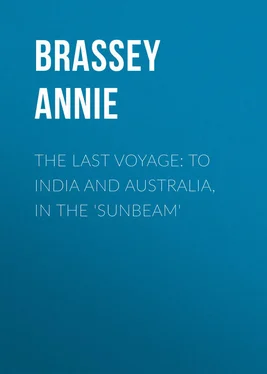Annie Brassey - The Last Voyage - To India and Australia, in the 'Sunbeam'
Здесь есть возможность читать онлайн «Annie Brassey - The Last Voyage - To India and Australia, in the 'Sunbeam'» — ознакомительный отрывок электронной книги совершенно бесплатно, а после прочтения отрывка купить полную версию. В некоторых случаях можно слушать аудио, скачать через торрент в формате fb2 и присутствует краткое содержание. ISBN: , Издательство: Иностранный паблик, Жанр: foreign_antique, foreign_prose, на английском языке. Описание произведения, (предисловие) а так же отзывы посетителей доступны на портале библиотеки ЛибКат.
- Название:The Last Voyage: To India and Australia, in the 'Sunbeam'
- Автор:
- Издательство:Иностранный паблик
- Жанр:
- Год:неизвестен
- ISBN:http://www.gutenberg.org/ebooks/29778
- Рейтинг книги:3 / 5. Голосов: 1
-
Избранное:Добавить в избранное
- Отзывы:
-
Ваша оценка:
- 60
- 1
- 2
- 3
- 4
- 5
The Last Voyage: To India and Australia, in the 'Sunbeam': краткое содержание, описание и аннотация
Предлагаем к чтению аннотацию, описание, краткое содержание или предисловие (зависит от того, что написал сам автор книги «The Last Voyage: To India and Australia, in the 'Sunbeam'»). Если вы не нашли необходимую информацию о книге — напишите в комментариях, мы постараемся отыскать её.
The Last Voyage: To India and Australia, in the 'Sunbeam' — читать онлайн ознакомительный отрывок
Ниже представлен текст книги, разбитый по страницам. Система сохранения места последней прочитанной страницы, позволяет с удобством читать онлайн бесплатно книгу «The Last Voyage: To India and Australia, in the 'Sunbeam'», без необходимости каждый раз заново искать на чём Вы остановились. Поставьте закладку, и сможете в любой момент перейти на страницу, на которой закончили чтение.
Интервал:
Закладка:
Never was any place so totally unlike what I had expected – in fact, it did not in the least correspond to the idea which any of us had formed about it. The palace of the Governor (who was for over three centuries called the Viceroy) stands in the city of Pangim, or New Goa, which, as I have already said, has been built on the river Mandovi, about five miles from its mouth. Curiously enough, the present Governor of Goa is our old friend Captain da Carvalho, who commanded the corvette 'Affonso Albuquerque' when she brought the King of Portugal to Plymouth last year, and lay alongside us for a fortnight in lovely Barn Pool, under the shadow of the Mount Edgcumbe trees. As we steamed over the bar and, aided by a strong flood-tide, quickly ascended the river, we next came to the pretty village of Raibandar, passing between low reedy banks fringed with cocoa-nut palms and other vegetation. The distant Ghâts formed a fine background to the picture, which included several white-spired English-looking churches, perched here and there on convenient knolls. The inhabitants of the district, however, composed as they are of descendants of the original natives found here by the Portuguese conquerors at the beginning of the sixteenth century, with a subsequent slight admixture of European blood, bore no resemblance to the British type. Those whom we saw on the river wore scarcely any clothing, and paddled about in little canoes somewhat similar to those used in the South Sea Islands and Ceylon. These boats are extremely narrow, and are provided with an outrigger in the shape of an enormous rough block of wood, connected with the canoes by bent spars some four feet long.
After a pleasant voyage of about eleven miles in tow of the steam-launch, we were suddenly cast off at some steps leading to a small pier, in the midst of a large grove of palm-trees, and were told that we had reached our destination. But where was Goa? We were all expecting to see ruined palaces, churches, and houses; whereas all that was visible was one massive arch and gateway about a hundred yards distant, standing, like the Irishman's 'main gate,' in the centre of a field, with no wall on either side of it. Meaningless as it now looked, this was the celebrated Arco dos Vicereys , or Arch of the Viceroys, originally built in 1599, and composed of blocks of black granite, now partially whitewashed. Through this gateway each successive ruler of Goa passed on his way to the ancient capital; on which occasions it was always splendidly decorated. A statue of St. Catherine, patroness of the city of Goa, occupies an upper niche, while beneath her is a figure of Vasco de Gama, with features somewhat defaced by time. The façade used to be adorned with paintings representing incidents of the Portuguese war in the Indies; but they are now effaced by whitewash. The portico bears an inscription dedicating it to the Immaculate Conception, and commemorating the emancipation of Portugal from Spain in 1656.
By this time the heat had become so great that, finding no carriage was forthcoming, I had almost resolved to give up the idea of visiting the wonderful old palaces and churches which we had taken so much trouble to come and see; but Tom and the Doctor encouraged me to make an effort, and improvised a sort of carrying-chair for me. We accordingly proceeded up a steep hot road, through the aforesaid arch, to the Rua Direita, so called because it once led direct from the Palace of the Viceroys to the Church of Misericordia. The name has lost its meaning, for all that now remains of the splendid palace is a portion of the chief gateway, so small in extent that when we tried to take a photograph of it, the helmet of one of the gentlemen who chanced to stand some distance in front of the camera completely concealed it. Only 250 years ago the palace must have been the most conspicuous building in the city. At that time a large square stood in front of it to the south, surrounded by fine houses. A noble staircase led from this square to the principal hall of the palace, in which were hung pictures of most of the Portuguese ships which had come to India since the time of Vasco de Gama. In an inner hall the Viceroy, who then lived in a style of regal splendour, received ambassadors from the Indian princes, and transacted important business. Da Fonseca, in his historical and archæological description of the City of Goa, states that the Viceroy rarely stirred out of his palace, except to make a royal progress through the city. 'A day previous to his appearance in public, drums were beaten and trumpets sounded, as a signal to the noblesse and gentry to accompany him on the following day. Accordingly, early in the morning about three or four hundred hidalgos and courtiers appeared in the Terriero do Paço , clad in rich attire, mounted on noble steeds with gold and silver trappings glittering with pearls and precious stones, and followed by European pages in rich livery.' The palace began to fall into decay when the city was abandoned; and although from time to time there was an idea of repairing it, the work was never seriously undertaken. In 1820 a considerable portion of the splendid building was ordered to be knocked down; and though the remainder stood for some time, even so lately as up to fifty or sixty years ago, it has gradually fallen to pieces, and its ruins are now covered with vegetation.
The small Church of S. Cajetan was the first place we visited after passing the entrance to the palace. It was built by some Italian friars in 1640, and so closely adjoins the palace that some travellers have referred to it as the Viceregal Chapel. The façade, with its Corinthian columns, and the fine cupola rising behind them, reminds one of St. Peter's at Rome in miniature. Outside the church, exposed to the full heat of the burning sun, a party of half-clad natives were scrubbing with soap and water some fine full-length oil portraits of past viceroys, governors, and archbishops, which had been removed from the sacristy for this purpose. Among them were those of Vasco de Gama, and of Affonso Albuquerque, the first European conqueror of Goa. The church had not yet been opened, so we waited in a long room in the adjacent convent, through which the sea-breeze blew with delicious coolness. After a short rest we went out into a balcony and looked with delight over a forest of tropical vegetation, to the blue river running swiftly through the trees, with the paler grey of the distant ghâts beyond. When at last we gained admittance to the church, we much admired its graceful dome and the fine altar-piece in the principal chapel. Close to and in striking contrast with this grand painting stood a little group of scantily clothed natives, who had evidently taken advantage of the opportunity of inspecting the sacred edifice which our visit afforded. The windows of the church are made of small panes of the thin, semi-transparent inner scale of the pearl oyster, used in place of glass – a fashion still followed in many of the private houses of Goa. These shell windows, the materials for which must formerly have been very plentiful in the neighbourhood, admit a peculiarly soft and tender light.
From S. Cajetan we proceeded to the Cathedral of S. Caterina, one of the oldest buildings of Goa, and the only church in which daily religious service on a grand scale is now held. Albuquerque was the founder of this sacred edifice, which took seventy-five years to build, and has been well described as 'worthy of one of the principal cities of Europe.' Dr. Russell, visiting it with H.R.H. the Prince of Wales, speaks of its 'vast and noble proportions.' We were amazed by the richness of the materials, and the artistic beauty of the elaborate carving which met the eye in every direction. The vaulted ceiling, the mosaic covered side-chapels, and the high altar, near which stands the Archbishop's chair, are the features most worthy of attention. The cathedral is, indeed, a stately pile, the nave being over 70 feet high and 140 feet long, and the total length of the building more than 270 feet. The vestries and sacristies are full of rich vestments and valuable plate, now seldom seen except by a few priests, or an occasional foreign visitor like ourselves, or, at still rarer intervals, by the general public when a grand exhibition is held, to which the faithful flock in crowds. Even the exhibitions have been discontinued of late years, for it was found that the gathering together of a large concourse of people in so unhealthy a locality led to the spread of infectious disorders. The site of Old Goa is, indeed, terribly malarious. The Government having abandoned the city, it was deserted by everybody else, the finest houses, after standing empty for years, gradually falling to pieces, so that literally not one stone remains above another. Old Goa was one of the headquarters of the terrible Inquisition, and until comparatively recent days its most cruel decrees were there executed with stern and heartless rigour. The tower of the Cathedral of S. Caterina contains five bells, the largest of which, still in daily use, is the same which was formerly tolled on the occasion of the auto-da-fé . It was quite thrilling to listen to its deep knell, and to think that those same tones must have fallen upon the agonised ears of the poor victims of an odious tyranny.
Читать дальшеИнтервал:
Закладка:
Похожие книги на «The Last Voyage: To India and Australia, in the 'Sunbeam'»
Представляем Вашему вниманию похожие книги на «The Last Voyage: To India and Australia, in the 'Sunbeam'» списком для выбора. Мы отобрали схожую по названию и смыслу литературу в надежде предоставить читателям больше вариантов отыскать новые, интересные, ещё непрочитанные произведения.
Обсуждение, отзывы о книге «The Last Voyage: To India and Australia, in the 'Sunbeam'» и просто собственные мнения читателей. Оставьте ваши комментарии, напишите, что Вы думаете о произведении, его смысле или главных героях. Укажите что конкретно понравилось, а что нет, и почему Вы так считаете.









![John Bruce - The Lettsomian Lectures on Diseases and Disorders of the Heart and Arteries in Middle and Advanced Life [1900-1901]](/books/749387/john-bruce-the-lettsomian-lectures-on-diseases-and-disorders-of-the-heart-and-arteries-in-middle-and-advanced-life-1900-1901-thumb.webp)


